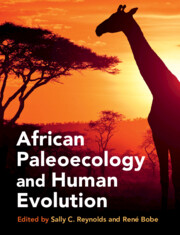Book contents
- African Paleoecology and Human Evolution
- African Paleoecology and Human Evolution
- Copyright page
- Dedication
- Contents
- Contributors
- Acknowledgments
- Part I Modern Africa and Overview of Late Cenozoic Paleoenvironments
- Part II Southern Africa
- 6 The Southern African Sites
- 7 Geology, Fauna, and Paleoenvironmental Reconstructions of the Makapansgat Limeworks Australopithecus africanus-Bearing Paleo-Cave
- 8 Paleoenvironments and the Context of Plio-Pleistocene Hominins at Kromdraai, South Africa
- 9 Using the Faunal Community to Determine the Local Ecology for Early Hominins at Cooper’s Cave at 1.5 Ma
- 10 The Paleoenvironments of Sterkfontein
- 11 Swartkrans: A Record of Paleoenvironmental Change in the Cradle of Humankind
- 12 Cornelia-Uitzoek: Paleoecology, Archeology, and Geochronology
- 13 The Paleoecology of the Australopithecus africanus Type Site at Taung, South Africa
- 14 Wonderwerk Cave, Northern Cape Province: An Early–Middle Pleistocene Paleoenvironmental Sequence for the Interior of South Africa
- Part III Eastern and Central Africa
- Part IV Northern Africa
- Volume References
- Index
- Plate Section (PDF Only)
11 - Swartkrans: A Record of Paleoenvironmental Change in the Cradle of Humankind
from Part II - Southern Africa
Published online by Cambridge University Press: 19 May 2022
- African Paleoecology and Human Evolution
- African Paleoecology and Human Evolution
- Copyright page
- Dedication
- Contents
- Contributors
- Acknowledgments
- Part I Modern Africa and Overview of Late Cenozoic Paleoenvironments
- Part II Southern Africa
- 6 The Southern African Sites
- 7 Geology, Fauna, and Paleoenvironmental Reconstructions of the Makapansgat Limeworks Australopithecus africanus-Bearing Paleo-Cave
- 8 Paleoenvironments and the Context of Plio-Pleistocene Hominins at Kromdraai, South Africa
- 9 Using the Faunal Community to Determine the Local Ecology for Early Hominins at Cooper’s Cave at 1.5 Ma
- 10 The Paleoenvironments of Sterkfontein
- 11 Swartkrans: A Record of Paleoenvironmental Change in the Cradle of Humankind
- 12 Cornelia-Uitzoek: Paleoecology, Archeology, and Geochronology
- 13 The Paleoecology of the Australopithecus africanus Type Site at Taung, South Africa
- 14 Wonderwerk Cave, Northern Cape Province: An Early–Middle Pleistocene Paleoenvironmental Sequence for the Interior of South Africa
- Part III Eastern and Central Africa
- Part IV Northern Africa
- Volume References
- Index
- Plate Section (PDF Only)
Summary
The first hominin fossils were recovered from Swartkrans by Robert Broom and John Robinson of the Transvaal Museum, working at the site at the behest of Wendell Phillips of the University of California’s Africa Expedition, in September of 1948. Broom considered the Swartkrans fossils to represent a new species of robust australopith that he named Paranthropus crassidens (Broom, 1949), although the material was later transferred to P. robustus (Robinson, 1954, 1956). Excavations continued through 1949, when a shortage of funds brought work to an end in November of that year. During the succeeding Christmas holiday, a local lime miner by the name of Fourie moved into Swartkrans and began blasting operations to remove a recently exposed seam of limestone for use by the gold-mining industry in nearby Krugersdorp. Broom and Robinson occasionally returned to the site to inspect the breccia that was also being loosened during the course of Fourie’s limestone blasting, which resulted in the recovery of several spectacular australopith specimens such as SK 23 and SK 48. In addition, Broom and Robinson recovered several specimens that could be attributed to early Homo, such as SK 15 and SK 45 (Broom and Robinson, 1949, 1952). Because SK 15 was derived from the “brown breccia” (Member 2, see below), Broom and Robinson initially held it to be considerably younger than the australopith fossils recovered from the “pink breccia” (Hanging Remnant of Member 1, see below). However, SK 45 was derived from the same “pink breccia” that had produced so many P. robustus fossils, and thus demonstrated for the first time the coexistence of multiple species of early hominin (Broom and Robinson, 1952). Broom died in 1951, but Robinson continued to conduct paleontological research at the site until 1953, unearthing numerous additional hominin fossils.
- Type
- Chapter
- Information
- African Paleoecology and Human Evolution , pp. 102 - 119Publisher: Cambridge University PressPrint publication year: 2022



